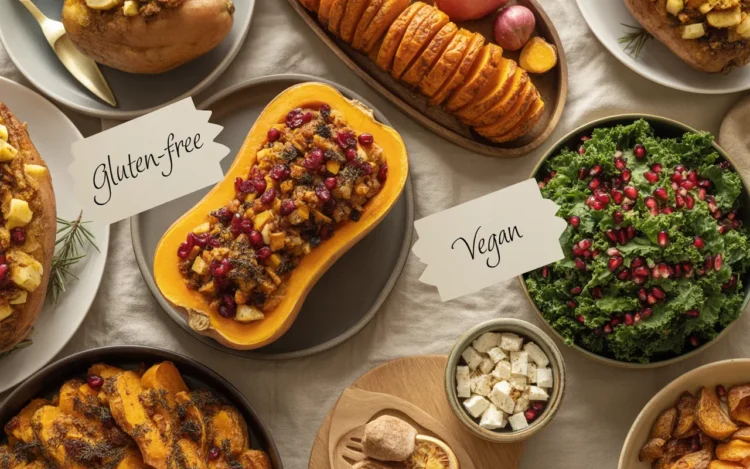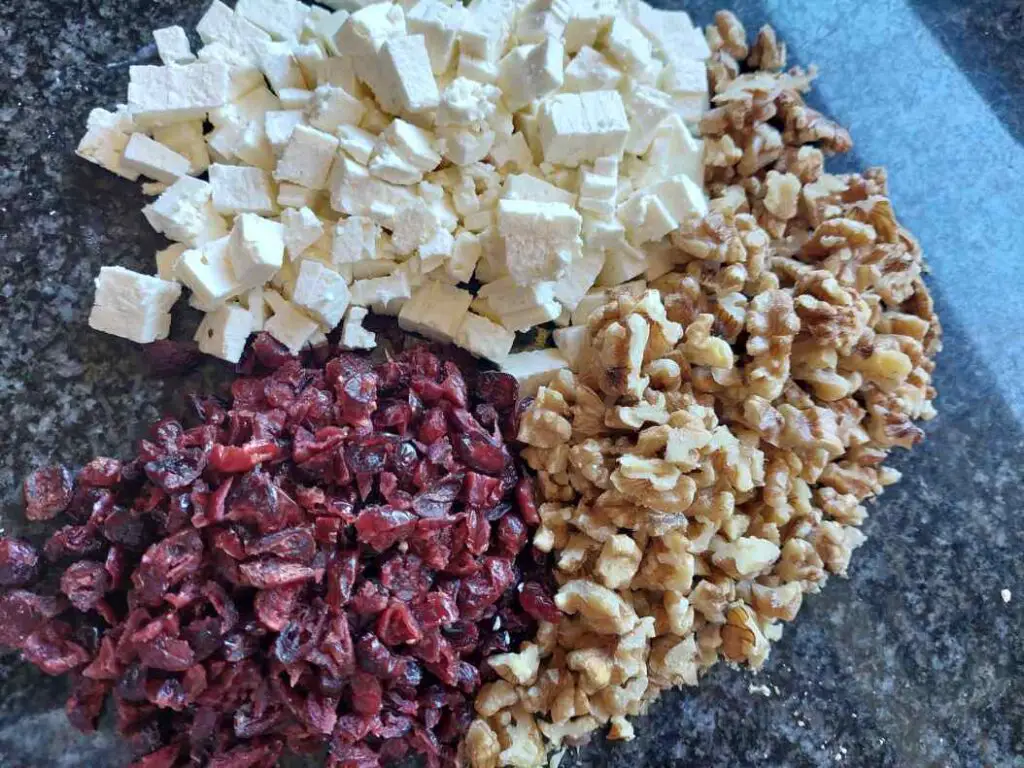Key Takeaways
- Create a memorable Thanksgiving feast that accommodates multiple dietary needs without sacrificing flavor
- Incorporate colorful, nutrient-dense options like our kale-based sides and salads
- Plan ahead with clearly labeled dishes to prevent cross-contamination
- Balance traditional favorites with creative alternatives for dietary restrictions
- Focus on naturally accommodating ingredients that everyone can enjoy
Introduction: Making Thanksgiving Inclusive Without Boring Anyone to Tears
Thanksgiving should be a time of gratitude and togetherness, not a dietary minefield where half your guests are left picking sadly at plain vegetables. At Whaley Cooks, we believe that accommodating dietary restrictions doesn’t mean serving up bland, joyless alternatives that make your gluten-free cousin cry into their dry rice cake.
Let’s face it – too often, “alternative” food options are about as exciting as watching paint dry. But who says your vegan niece has to endure a sad mushroom patty while everyone else feasts? Or that your lactose-intolerant brother-in-law should spend Black Friday regretting that hidden dairy in the mashed potatoes? The reality is that with thoughtful planning and creative approaches, everyone at your table can enjoy a delicious, satisfying meal that honors both tradition and individual dietary needs.
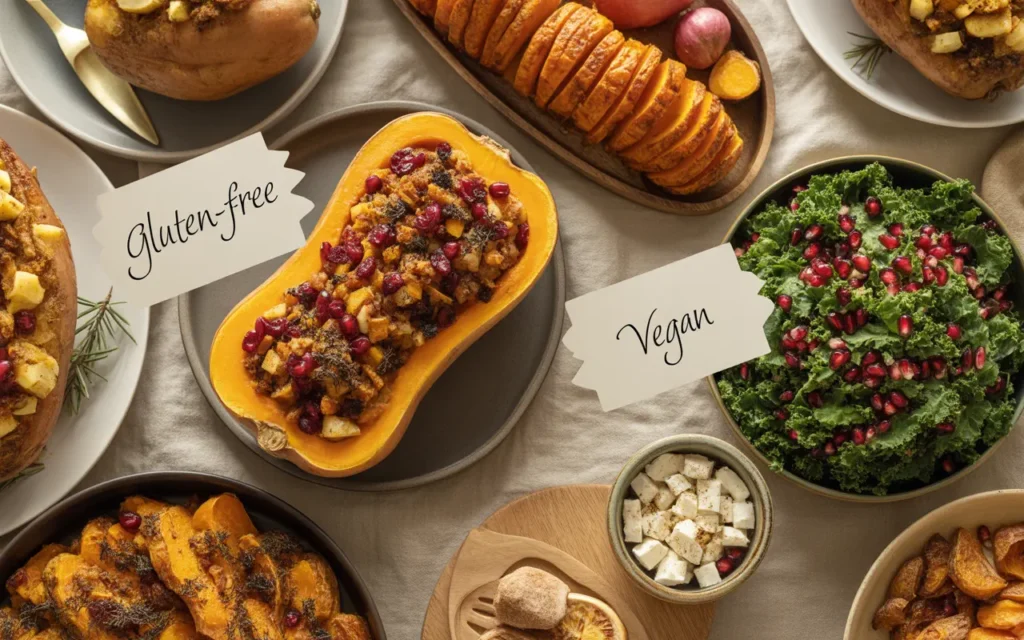
In this guide, we’ll walk you through creating a Thanksgiving menu that’s as quirky and interesting as your eccentric uncle’s holiday stories – but with the crucial difference that everyone, regardless of dietary restrictions, will actually enjoy it. From gluten-free stuffing that doesn’t taste like sawdust to dairy-free sides that will have even the most dedicated cheese-lovers asking for seconds, we’ve got you covered. We’ll explore practical strategies for accommodating common dietary restrictions including gluten-free, dairy-free, vegan, and nut-free options that will impress even your most discerning guests.
Our approach? Make food so good that nobody realizes it’s “alternative” until you smugly tell them after they’ve cleaned their plate. Because the best compliment for an inclusive Thanksgiving feast isn’t “this is good for being gluten-free” – it’s simply “this is delicious, may I have seconds?” So roll up your sleeves and prepare to create a Thanksgiving spread that celebrates both tradition and inclusion, without compromising on flavor or fun.
1. The Art of Planning: Mapping Out Your Dietary-Friendly Feast
Before you start cooking, you need a battle plan. Hosting a Thanksgiving with multiple dietary restrictions is like conducting an orchestra – except all the instruments are made of food and some of them might kill someone if played incorrectly. The key to success lies not just in finding alternative recipes, but in strategic planning that minimizes stress while maximizing enjoyment for all your guests.
Start by surveying your guests about their dietary needs well in advance. This isn’t just polite; it’s strategic. Knowing that Aunt Martha has celiac disease and your college roommate has gone vegan lets you plan a menu that accommodates everyone without making seven entirely different meals. Consider sending out a simple questionnaire with your invitation, asking guests to specify any dietary restrictions, allergies, or strong preferences. This proactive approach demonstrates your commitment to inclusivity while giving you valuable information for menu planning.

Consider creating a shared spreadsheet or document where guests can note their restrictions. This might seem overly organized, but it’s far better than discovering at dinner time that your perfectly roasted turkey is useless to half the table. Having this information centralized helps you identify overlap in dietary needs and spot opportunities for dishes that can serve multiple purposes. For example, you might notice that several guests avoid dairy for different reasons, allowing you to focus on creating one exceptional dairy-free gravy rather than multiple alternatives.
When planning quantities, our guide to Thanksgiving dinner planning for crowds can help you calculate exactly how much food you’ll need. For the turkey itself, check out our turkey portion calculator to ensure you’re buying the right size bird. Remember to factor in dietary restrictions when calculating portions – if half your guests won’t be eating turkey, you can adjust your quantities accordingly and perhaps invest more in spectacular vegetarian mains.
Pro tip: Design your menu so that many dishes can be made with simple modifications to accommodate different needs. For example, set aside some of your mashed potatoes before adding butter and milk, then dress up the dairy-free portion with roasted garlic and olive oil. This approach means you’re not cooking entirely different meals but rather creating inclusive variations. Similarly, prepare stuffing outside the bird to keep it vegetarian-friendly, and consider having separate serving utensils for each dish to prevent cross-contamination that could affect guests with severe allergies.
📋Survey Guests: Collect dietary restrictions 2-3 weeks before Thanksgiving
🍽️Plan Adaptable Dishes: Design a menu with modifiable recipes rather than separate meals
🏷️Label Everything: Create clear labels for each dish listing ingredients and accommodations
Remember, the goal isn’t just to provide “safe” food for everyone – it’s to ensure that every guest feels equally valued and can enjoy a delicious, memorable meal. With proper planning, your dietary-accommodating Thanksgiving can be a triumph rather than a logistical nightmare. Consider creating a detailed timeline for the days leading up to Thanksgiving, noting which dishes can be prepared in advance and which require last-minute attention. This approach helps prevent kitchen chaos and ensures that you can enjoy the celebration alongside your guests rather than frantically troubleshooting food issues.
2. Appetizers & Starters: Kicking Off with Inclusive Nibbles
The Thanksgiving appetizer spread sets the tone for your meal, and it’s the perfect opportunity to showcase how accommodating dietary restrictions can result in food that’s interesting, not bland. Let’s ditch the sad celery sticks and create starters everyone will fight over. Appetizers offer a wonderful chance to introduce vibrant flavors and textures that complement the traditional Thanksgiving palette while meeting diverse dietary needs.

Soup Shooters with a Twist
Soup shooters are perfect for Thanksgiving – they’re elegant, warming, and can easily be made to accommodate various dietary needs. Consider offering these sophisticated yet simple options that provide a delightful introduction to your meal while satisfying diverse preferences.
Butternut Squash Bisque (Vegan Version): Replace heavy cream with coconut milk for a dairy-free option that’s still velvety and rich. The natural sweetness of butternut squash means you won’t miss a thing. Enhance the flavor profile with warming spices like nutmeg, cinnamon, and a touch of curry powder for an unexpected depth. Garnish with toasted pepitas for crunch and a visual flourish that makes these shooters Instagram-worthy.
Tom Yum Inspired Soup: For something unexpected, try a Thai-inspired soup with lemongrass, lime, and mushrooms. It’s naturally gluten-free, can be made vegan by omitting the fish sauce, and brings a welcome brightness to counter the traditional heavy Thanksgiving flavors. The aromatic herbs and subtle heat from Thai chilis provide a palate-awakening contrast to the rich dishes that will follow. Consider serving these in shot glasses with a thin slice of lime on the rim for an elegant presentation.
Crudité Reinvented
Vegetable platters don’t have to be boring! Create a stunning display with thoughtfully prepared vegetables that elevate this standard appetizer into something truly special. The key is to focus on preparation techniques and complementary flavors that transform simple vegetables into crave-worthy starters.
Roasted Vegetable Skewers: Thread seasonal vegetables like Brussels sprouts, butternut squash, and red onion on skewers, roast until caramelized, and serve warm with a tahini drizzle (vegan and gluten-free). The roasting process brings out the natural sugars in the vegetables, creating complex flavors that far surpass raw veggie platters. For an extra touch, try brushing the vegetables with maple-balsamic glaze before roasting to create a sweet-tangy exterior that complements the caramelization.
Stuffed Mushroom Caps: Fill with a mixture of gluten-free breadcrumbs, herbs, and either vegan cheese or the real deal (label accordingly). For the vegan version, nutritional yeast adds a satisfying cheesy flavor, while finely chopped walnuts provide textural contrast. These can be prepared in advance and simply reheated before serving, making them a practical choice for busy hosts. Consider offering two clearly labeled varieties to accommodate different dietary needs while providing options everyone will enjoy.
Dips That Delight Everyone
Dips are the great equalizer – they can be made to suit almost any dietary restriction while still being crowd-pleasers. The versatility of dips makes them perfect for an inclusive appetizer spread, and thoughtful presentation elevates them from casual to celebration-worthy.
Roasted Garlic Hummus: Naturally vegan and gluten-free, serve with both gluten-free crackers and regular pita for everyone to enjoy. Roasting the garlic transforms the flavor profile, creating a sweet, mellow garlic note rather than the sharp bite of raw garlic. Consider incorporating seasonal elements like pumpkin puree or roasted butternut squash for a Thanksgiving-appropriate variation that maintains the creamy texture while introducing festive flavors.
Cranberry Salsa: A Thanksgiving-appropriate twist on traditional salsa, mixing fresh cranberries with jalapeño, cilantro, and lime. It’s bright, unexpected, and accommodates most dietary restrictions. The vibrant color makes for a stunning presentation, while the combination of tart cranberries and spicy jalapeños creates an addictive flavor profile that keeps guests coming back for more. Serve with blue corn tortilla chips for a visually striking appetizer that breaks from Thanksgiving tradition while incorporating seasonal ingredients.
For a truly spectacular starter that accommodates multiple dietary needs, try our Simply Indulgent Kale Salad with Cranberry, Walnut, and Feta. This nutrient-packed salad can be easily modified by serving the feta cheese on the side for dairy-free guests. The combination of hearty kale, tart cranberries, and crunchy walnuts makes for a festive start to your meal. The sturdy kale leaves stand up well to advance preparation, making this an ideal make-ahead option that actually improves as the flavors meld.
Remember to clearly label each appetizer with dietary information. Small place cards next to each dish can indicate if items are GF (gluten-free), DF (dairy-free), V (vegan), etc. This allows guests to navigate the spread confidently without having to ask about each item. Consider using decorative tags that match your table décor to make these informative labels part of your presentation rather than an afterthought. This thoughtful touch demonstrates your commitment to making all guests feel welcome and cared for from the moment they begin enjoying your Thanksgiving feast.
3. Main Event: Turkey and Its Alternatives
The centerpiece of most Thanksgiving tables is, of course, the turkey. But that doesn’t mean your non-meat-eating guests should be left with a sad plate of sides. Here’s how to create main dishes that will satisfy everyone from the most traditional turkey-lover to your vegan niece. The key is approaching alternative mains not as compromises but as equally worthy centerpieces that deserve the same attention to flavor, texture, and presentation as the turkey.
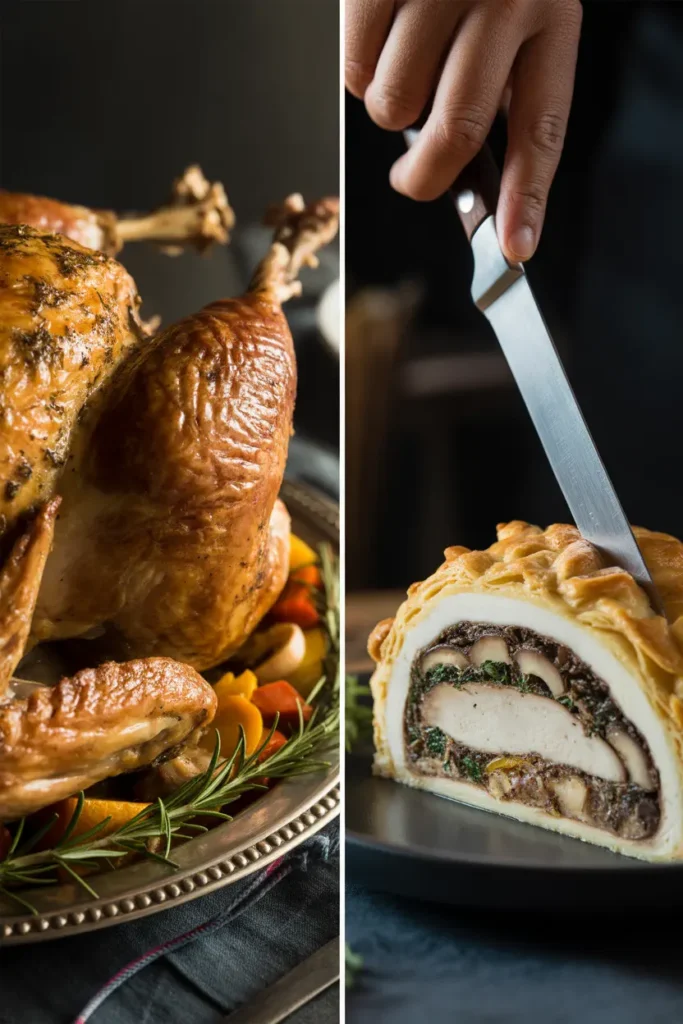
The Traditional Turkey – With a Twist
For your turkey, consider these tips to make it more accommodating while maintaining the traditional appeal that many guests expect. With thoughtful preparation, your turkey can be the centerpiece that pleases traditionalists while still respecting dietary considerations.
1. Brine, Don’t Butter: Many turkey recipes call for butter under the skin, but you can achieve equally juicy results with a good brine. This makes at least the turkey meat itself dairy-free. A simple brine of salt, sugar, herbs, and citrus infuses the meat with flavor and moisture without introducing dairy. For an extra flavor boost, consider adding apple cider to your brine, which introduces subtle sweetness and helps tenderize the meat naturally.
2. Separate the Stuffing: Rather than stuffing the bird (which creates cross-contamination issues for vegetarians), cook your stuffing separately. This also allows you to make multiple stuffing variations. As a bonus, separately cooked stuffing (technically “dressing”) develops better texture with crispy edges that many prefer. For those who insist on the flavor of in-bird stuffing, consider stuffing the cavity with aromatics like onions, herbs, and citrus that can be discarded after cooking but will infuse the meat with flavor.
3. Consider a Turkey Size Calculator: Use our guide to turkey portions to ensure you’re buying the right size bird for your gathering. This helps prevent food waste while ensuring you have enough to satisfy everyone who wants turkey. Remember that with multiple main options, you might need less turkey than for a traditional meal where it’s the only centerpiece. A good rule of thumb is to calculate based on the number of meat-eaters, then reduce slightly to account for those who will sample other main dishes.
Vegetarian & Vegan Main Alternatives
Don’t just offer a plate of sides to your vegetarian and vegan guests. Create a main dish worthy of centerpiece status that delivers the same satisfaction and visual impact as the turkey. These options are so delicious that even meat-eaters may want to sample them.
1. Stuffed Butternut Squash: Halve and roast butternut squashes, then fill with a wild rice pilaf studded with dried cranberries, toasted pecans, and herbs. It’s visually stunning, naturally vegan and gluten-free, and substantial enough to satisfy. The presentation of individual stuffed squash halves creates a special experience for plant-based eaters. For extra flavor, brush the squash with maple-sage butter (or vegan butter) before roasting to develop caramelization and enhance the natural sweetness.
2. Mushroom Wellington: For a show-stopping vegan main, wrap a savory mushroom, nut, and herb filling in dairy-free puff pastry. Slice it at the table for dramatic effect. The combination of umami-rich mushrooms (consider using a mix of varieties like portobello, cremini, and shiitake), crunchy nuts, and aromatic herbs creates a complex flavor profile that satisfies even dedicated meat-eaters. The golden, flaky pastry exterior provides the same visual appeal as a traditional roast.
3. Lentil and Vegetable Loaf: A hearty, protein-rich alternative to meatloaf that can be made gluten-free with the right breadcrumbs. The key to a successful lentil loaf is achieving the right texture – not too mushy or too dry. Incorporate finely chopped vegetables like carrots, celery, and mushrooms for texture variation, and top with a tangy glaze that caramelizes during baking. Slice and serve just as you would a traditional meatloaf for a familiar presentation that delivers plant-based nutrition.
Cross-Contamination Prevention Tips
- Use separate cutting boards and utensils for preparing vegan/vegetarian dishes
- Prepare allergen-free dishes first, before other cooking begins
- Consider using colored toothpicks or markers on serving utensils to designate which are for which dietary restriction
- Keep serving spoons separate – don’t let the gravy ladle touch the vegan gravy!
Gluten-Free Gravy That Everyone Will Love
Gravy is typically thickened with flour, making it problematic for gluten-free guests. Try this alternative approach that creates a rich, satisfying gravy everyone can enjoy without feeling like they’re settling for a lesser version.
Mushroom-Based Gluten-Free Gravy: – Sauté mushrooms until deeply browned – Add herbs and stock – Thicken with cornstarch instead of flour – For a vegan version, use vegetable stock instead of turkey drippings
This rich, umami-packed gravy is so good that even your traditionalist uncle won’t know it’s “alternative.” The key is developing deep flavor through proper browning of the mushrooms – don’t rush this step! Allow them to release their moisture and then caramelize for maximum flavor development. Consider adding a splash of dry sherry or white wine to deglaze the pan, introducing complexity that mimics the depth of traditional gravy. A touch of nutritional yeast can add savory notes for the vegan version, while a few drops of gluten-free tamari or coconut aminos boost umami without adding gluten.
Remember, the goal isn’t to create a completely separate meal for each dietary restriction, but rather to ensure that everyone has a satisfying, delicious main dish option that makes them feel included in the celebration. With thoughtful planning and preparation, your alternative mains can become new traditions that guests look forward to year after year.
4. Stuffing & Dressing: The Carb-Loaded Crowd-Pleaser
Stuffing (or dressing, depending on your regional terminology) is often the most beloved side dish at the Thanksgiving table. Unfortunately, traditional stuffing is also a minefield of dietary restrictions – it typically contains gluten, dairy, and sometimes meat. But fear not! We can create versions that accommodate various needs without sacrificing that perfect combination of soft and crispy textures. With the right approach, everyone can enjoy this quintessential Thanksgiving dish.

Base Stuffing Recipe with Variations
Start with a basic stuffing recipe that can be modified to suit different needs. This modular approach allows you to create multiple variations from a single base, streamlining your preparation while ensuring everyone has a suitable option. The key is establishing a solid foundation of flavor that works across variations.
Versatile Thanksgiving Stuffing Base: – Dried bread cubes (can use gluten-free bread) – Sautéed onions, celery, and carrots – Fresh herbs (sage, thyme, rosemary) – Vegetable or chicken stock – Salt and pepper
From this foundation, you can create variations to accommodate different dietary needs and preferences. The beauty of this approach is that you can prepare the base ingredients together, then divide them before adding ingredients that might trigger allergies or dietary restrictions:
1. Traditional: Add butter and eggs to the base, using chicken stock for moisture. For enhanced flavor, consider incorporating sausage (removed from casings and crumbled) that’s been browned with the vegetables. This version delivers the classic stuffing experience that traditionalists expect, with rich, savory notes and a perfect balance of soft interior and crispy top.
2. Gluten-Free: Use certified gluten-free bread cubes. The key is finding a good quality gluten-free bread that isn’t too crumbly. Consider toasting the bread cubes more thoroughly than you would regular bread to help them maintain structure when moistened. Adding a tablespoon of ground flaxseed mixed with water can help bind the stuffing if the gluten-free bread lacks the structure of wheat-based bread.
3. Vegan: Replace butter with olive oil, use vegetable stock, and skip the eggs (add a bit more liquid to compensate). For added richness, incorporate a few tablespoons of nutritional yeast, which provides a savory, almost cheesy flavor. Consider adding extra vegetables like mushrooms, which contribute meaty texture and umami flavor that makes this version satisfying even for non-vegans.
4. Kale Stuffing Special: Try our Spectacular Thanksgiving Cheesy Winter Green Stuffing with Kale – it’s a nutrient-dense twist on traditional stuffing that can be adapted for various dietary needs. The hearty kale holds up beautifully during baking and adds vibrant color that brightens your Thanksgiving table. For a dairy-free version, substitute the cheese with a cashew-based cheese alternative or simply increase the herbs and add nutritional yeast.
Beyond Bread: Alternative Stuffing Bases
For those avoiding grains entirely or looking for something different, consider these creative alternatives that maintain the spirit of stuffing while using entirely different base ingredients. These options are particularly good for guests following paleo, keto, or grain-free diets:
1. Wild Rice Stuffing: Wild rice mixed with dried fruits, nuts, and herbs makes a hearty alternative that’s naturally gluten-free. The chewy texture of wild rice provides a satisfying bite similar to bread-based stuffing. For best results, cook the rice until just tender (not mushy) and combine with plenty of sautéed vegetables, toasted nuts, and dried fruits that have been plumped in warm apple cider. The combination of textures and sweet-savory flavors creates a complex dish that stands on its own merits.
2. Quinoa Stuffing: High in protein and gluten-free, quinoa makes an excellent stuffing base when mixed with traditional stuffing flavors. Its fluffy texture absorbs flavors beautifully while providing nutritional benefits that bread-based stuffing lacks. For best results, toast the quinoa before cooking to enhance its nutty flavor, and use a mixture of vegetable or chicken stock with a splash of white wine for cooking liquid. The tiny grains create a lighter texture than traditional stuffing while still delivering satisfying flavor.
3. Cauliflower Stuffing: For a low-carb option, finely chopped cauliflower can mimic the texture of bread cubes surprisingly well. Roast the cauliflower first to remove excess moisture and develop flavor, then combine with traditional stuffing vegetables and herbs. The cauliflower absorbs the savory flavors while maintaining enough texture to prevent mushiness. This version is particularly good for those following ketogenic or low-carb diets who still want to participate in the stuffing tradition.
Stuffing Quantity Guide
Wondering how much stuffing to make? As a general rule:
- ¾ cup of stuffing per person for a side serving
- 1½ cups per person if your guests are stuffing enthusiasts
- Always make extra if you want leftovers (and who doesn’t?)
Make-Ahead Tips
Stuffing is perfect for advance preparation, which can significantly reduce your stress on Thanksgiving Day. Follow these steps for make-ahead success that doesn’t compromise flavor or texture:
1. Prepare your stuffing up to the baking point a day ahead. Sauté all vegetables, combine with bread or alternative base, and add liquids and seasonings. Transfer to your baking dish, cover tightly, and refrigerate.
2. Refrigerate overnight, allowing the flavors to meld and the base to fully absorb the liquid. This actually improves most stuffing recipes, developing deeper flavor complexity than same-day preparation.
3. Bring to room temperature before baking (about 30 minutes on the counter). This ensures even cooking and reduces baking time.
4. Add a bit more stock if it seems dry after refrigeration. Different bread varieties absorb liquid at different rates, so check consistency before baking and adjust as needed.
Remember to clearly label each stuffing variation and keep serving utensils separate to prevent cross-contamination. Consider using decorative flags or different serving dishes to help guests easily identify which stuffing meets their dietary needs. With these strategies, everyone can enjoy this beloved Thanksgiving side dish without feeling excluded or compromising on flavor.
5. Sides That Steal the Show: Vegetables & Starches
Side dishes are where dietary-friendly Thanksgiving menus can truly shine. With a little creativity, vegetable and starch sides can be the most talked-about dishes on the table, regardless of dietary restrictions. Far from being afterthoughts, thoughtfully prepared sides can become the highlights of your meal, offering vibrant colors, diverse textures, and bold flavors that complement the traditional centerpieces.
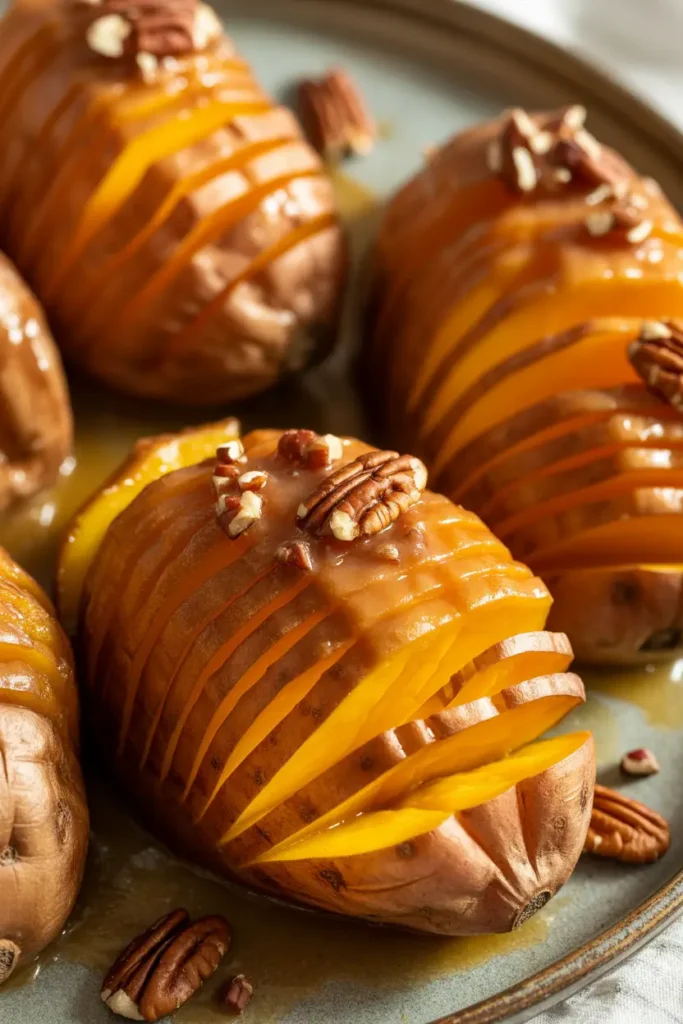
Root Vegetables Reimagined
Root vegetables are Thanksgiving staples that can easily be made to accommodate various dietary needs. Their natural sweetness and hearty texture make them perfect candidates for creative preparations that satisfy diverse preferences while honoring seasonal ingredients.
1. Maple-Roasted Rainbow Carrots: Toss heirloom carrots in maple syrup, olive oil, and thyme, then roast until caramelized. Naturally vegan and gluten-free, these colorful carrots bring visual appeal to your table. The variety of purple, yellow, and orange carrots creates a stunning presentation that elevates this simple vegetable to centerpiece status. For added complexity, finish with a sprinkle of dukkah (an Egyptian nut and spice blend) or toasted pumpkin seeds for textural contrast and visual interest.
2. Hasselback Sweet Potatoes: Instead of the traditional marshmallow-topped casserole (which contains gelatin, making it non-vegetarian), try thinly sliced Hasselback sweet potatoes drizzled with a pecan-maple glaze. They’re showstoppers that happen to be vegan and gluten-free. The thin slices create maximum surface area for caramelization, resulting in crispy edges and tender centers. The individual presentation makes serving easy while allowing guests to control their portion size. For an extra flavor dimension, try infusing the maple syrup with a cinnamon stick, star anise, and orange zest before drizzling over the potatoes.
3. Roasted Garlic Mashed Potatoes: Create a base mashed potato recipe using roasted garlic for flavor, then divide it: – For traditional diners: Add butter and cream – For dairy-free guests: Use olive oil and vegetable stock – For vegan guests: Add nutritional yeast for a cheesy flavor
The roasted garlic provides such rich flavor that even the dairy-free versions taste indulgent. Consider roasting a whole head of garlic for each pound of potatoes to ensure robust flavor throughout. For presentation, create a “mashed potato bar” with the base potato recipe and various mix-ins that guests can customize according to their preferences and dietary needs.
Green Vegetables with Personality
Green vegetables don’t have to be the boring afterthought on your Thanksgiving table. With thoughtful preparation and bold flavors, they can become standout dishes that offer a welcome contrast to the richer elements of your meal.
1. Brussels Sprouts with Balsamic Glaze: Roast Brussels sprouts until crispy, then drizzle with a reduced balsamic glaze and sprinkle with pomegranate seeds for a pop of color and flavor. The combination of caramelized sprouts, tangy-sweet glaze, and juicy pomegranate seeds creates a perfect balance of flavors and textures. This dish is naturally vegan, gluten-free, and visually stunning with the ruby-red pomegranate against the deep green sprouts. For maximum caramelization, halve the sprouts and roast cut-side down on a preheated baking sheet.
2. Green Beans with Caramelized Shallots: Skip the traditional cream-based casserole and opt for fresh green beans sautéed with caramelized shallots and finished with a sprinkle of toasted almonds. This lighter preparation allows the vegetable’s natural flavor to shine while still offering richness from the deeply caramelized shallots. Blanch the green beans briefly before sautéing to preserve their vibrant color and achieve the perfect tender-crisp texture. For a dairy-free flavor boost, finish with a splash of sherry vinegar or lemon juice just before serving.
3. Kale Salad Extraordinaire: Our Simply Indulgent Kale Salad with Cranberry, Walnut, and Feta makes a perfect Thanksgiving side. For dairy-free guests, simply omit the feta or serve it on the side. The hearty kale stands up beautifully to advance preparation and won’t wilt like more delicate greens. The combination of chewy dried cranberries, crunchy walnuts, and tangy dressing creates a complex flavor profile that complements the traditional Thanksgiving flavors. Massage the kale with a bit of the dressing about 30 minutes before serving to tenderize the leaves while maintaining their structure.
Grains and Starches Beyond the Ordinary
Expand your starch offerings beyond the typical mashed potatoes with these creative alternatives that provide interesting textures and flavors while accommodating various dietary needs. These options can serve as both substantial sides for meat-eaters and satisfying main components for plant-based guests.
1. Wild Rice Pilaf: A nutty, chewy alternative that’s naturally gluten-free and can be made vegan by using olive oil instead of butter. Enhance the pilaf with seasonal additions like roasted butternut squash, dried cherries, and toasted hazelnuts for a dish that’s both substantial and festive. The varied textures and flavors make this much more interesting than plain rice, while the nutrient density makes it suitable as a significant component of the meal for those with dietary restrictions.
2. Quinoa Stuffed Acorn Squash: Halved acorn squashes roasted and filled with herb-flecked quinoa, dried cranberries, and toasted pepitas create individual servings that are as beautiful as they are delicious. The presentation in the natural “bowl” of the squash half makes for an elegant serving option that keeps the components separate for those with specific dietary needs. The combination of protein-rich quinoa and sweet roasted squash creates a nutritionally complete dish that can serve as a main course for plant-based eaters.
3. Roasted Garlic Cauliflower Mash: For low-carb or keto guests, cauliflower mash can be surprisingly creamy and satisfying. The roasted garlic adds depth that makes this more than just a potato substitute. For the creamiest texture, steam the cauliflower rather than boiling it to prevent waterlogging, then thoroughly drain and dry before processing. A high-powered blender creates the smoothest texture, while a food processor yields a more rustic result. For additional richness without dairy, consider incorporating a few tablespoons of cashew cream.
“The true spirit of Thanksgiving is found not in rigidly adhering to tradition, but in adapting those traditions to ensure everyone at your table feels welcomed and nourished.”
Remember to prepare and serve these sides in a way that prevents cross-contamination. Consider using separate serving utensils and clearly labeling each dish with its ingredients and accommodations. With these vibrant, flavorful sides, no one will feel like they’re missing out, regardless of their dietary restrictions. The diversity of colors, textures, and flavors creates a visually stunning table that invites everyone to explore new taste experiences while honoring the spirit of abundance that defines Thanksgiving.
6. Cranberry Creations: Beyond the Can
Cranberry sauce is one of the few Thanksgiving staples that’s naturally accommodating to most dietary restrictions. It’s typically vegan, gluten-free, and dairy-free – but that doesn’t mean it has to be boring or straight from the can. Let’s explore how to elevate this tart treat to star status. With its vibrant color and versatile flavor profile, cranberry sauce can be transformed into various incarnations that enhance your inclusive Thanksgiving spread.
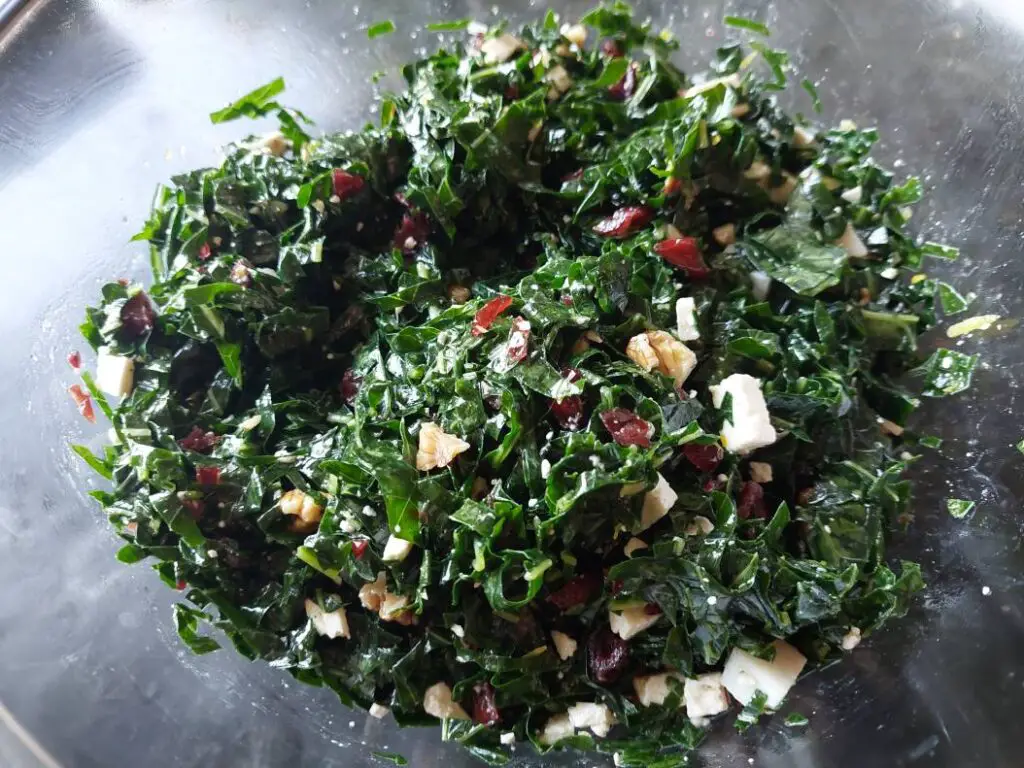
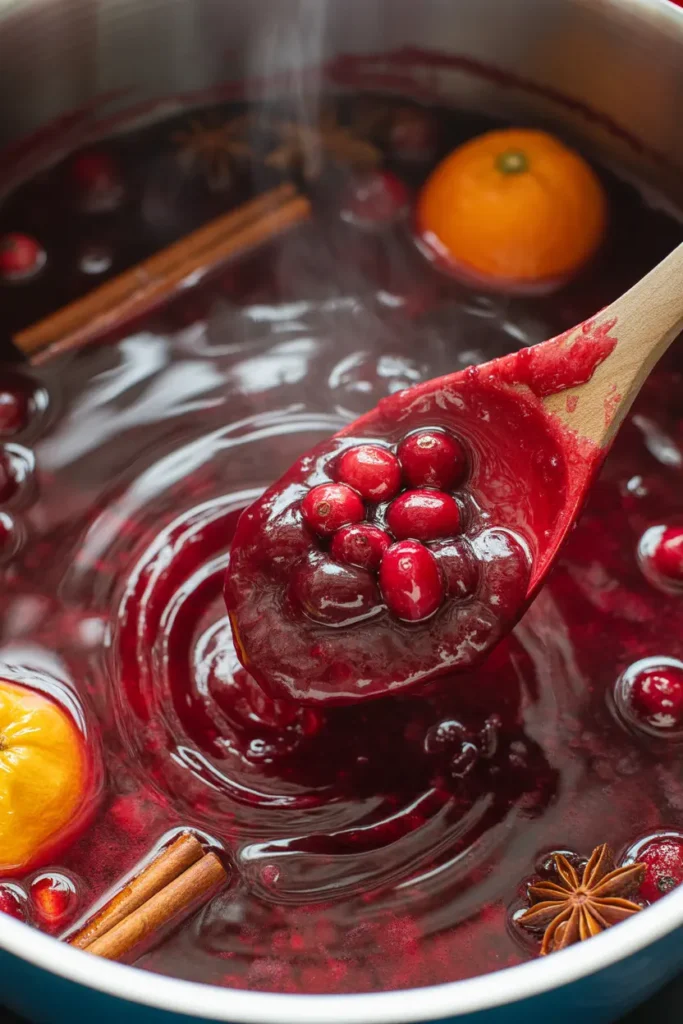
Homemade Cranberry Sauce Variations
The basic cranberry sauce recipe (cranberries, sugar, water) is incredibly versatile and can be customized in countless ways. By experimenting with different flavor profiles, you can create signature cranberry sauces that become annual traditions while accommodating virtually any dietary restriction.
1. Orange-Spiced Cranberry Sauce: Add orange zest, juice, and warming spices like cinnamon, clove, and star anise for a complex flavor profile. The citrus brightens the cranberries’ natural tartness while the spices add depth and aromatic complexity. For maximum orange flavor, include both the zest and juice of a whole orange, and consider adding a splash of Grand Marnier or orange liqueur for adult tables (the alcohol will cook off, leaving just the flavor). This version pairs beautifully with both traditional turkey and plant-based alternatives.
2. Maple-Sweetened Cranberry Sauce: Replace refined sugar with pure maple syrup for a more nuanced sweetness. This version appeals to those avoiding refined sugars while adding a woodsy depth that complements the berries’ brightness. Grade B maple syrup (now labeled as “Grade A Dark, Robust Taste”) provides the strongest maple flavor. For additional complexity, add a pinch of sea salt and a splash of bourbon, which enhances the maple notes without making the sauce taste alcoholic.
3. Cranberry-Apple Sauce: The addition of diced apples brings natural sweetness and textural contrast. Use a firm apple variety like Honeycrisp or Granny Smith. The apples soften as they cook but maintain enough structure to create interesting texture within the sauce. This variation allows you to reduce added sweeteners by leveraging the natural sugars in the apples. A touch of ginger and allspice enhances the apple flavor while complementing the tartness of the cranberries.
4. Ginger-Pear Cranberry Compote: Fresh ginger adds a zingy heat that balances the sweetness, while pears contribute a honey-like quality. The combination creates a sophisticated sauce that works equally well with savory and sweet applications. For best texture, use slightly underripe pears that will hold their shape during cooking. A splash of white wine added during cooking enhances the pears’ flavor and adds complexity to the finished sauce.
Sugar-Free and Reduced-Sugar Options
For guests managing diabetes or following low-sugar diets, cranberry sauce often presents a challenge due to its traditionally high sugar content. These variations offer the same festive flavor with significantly less impact on blood sugar levels:
1. Stevia-Sweetened Cranberry Sauce: Use stevia or monk fruit sweetener for a zero-glycemic index option. These natural sweeteners provide sweetness without the calories or glycemic impact of sugar. The key to success with stevia is adding it toward the end of cooking, as prolonged heat can create bitter notes. Consider combining stevia with a small amount of apple juice concentrate for a more balanced sweetness profile that masks stevia’s potential aftertaste.
2. Reduced-Sugar Version with Orange: The natural sweetness of orange juice allows you to cut the added sugar significantly. Simmer cranberries with fresh orange juice, orange zest, and just a small amount of honey or maple syrup. The extended cooking time concentrates the natural sugars in both the cranberries and orange juice, creating perceived sweetness with less added sweetener. Cinnamon and vanilla extract enhance the perception of sweetness without adding any sugar.
3. Cranberry-Applesauce Blend: Unsweetened applesauce mixed with cranberries reduces the need for added sweeteners. This approach leverages the natural sweetness of apples to balance cranberries’ tartness. For best results, use homemade unsweetened applesauce or a high-quality store-bought version with no added sugar.
7. Desserts: The Grand Finale Where No One Skips Out
The final hurdle! Traditional Thanksgiving dessert is a minefield of gluten (crust), dairy (butter, cream, evaporated milk), and eggs. This is where many hosts give up and buy a sad, store-bought sorbet. Don’t be that host. With a little creativity, you can offer a grand finale that’s as inclusive as it is indulgent.
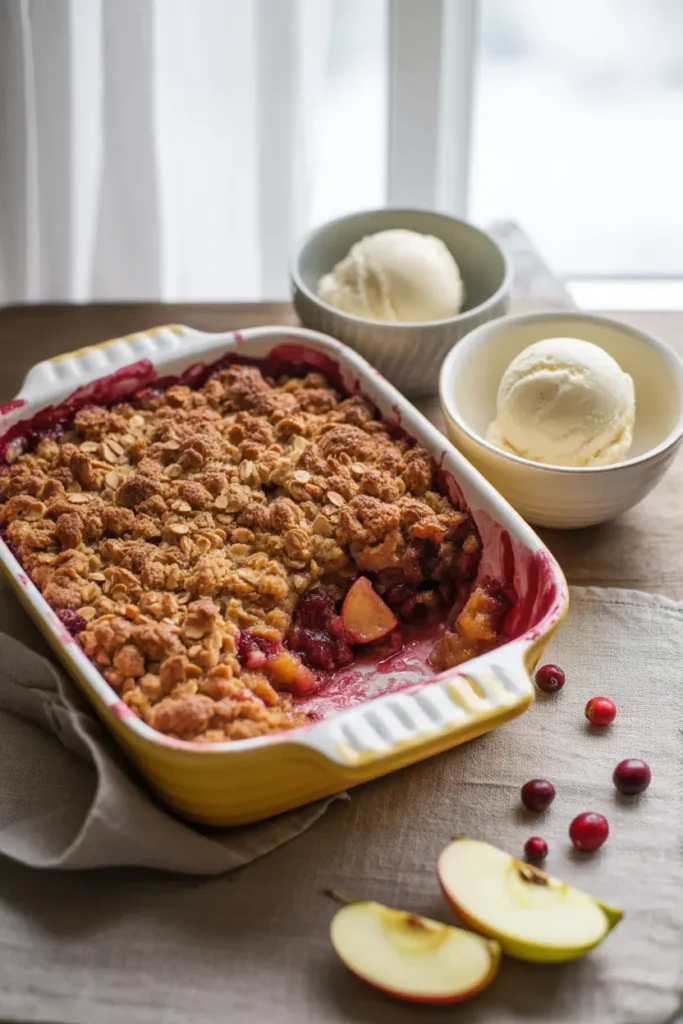
Crustless & Creative Pies
Let’s be honest, the filling is the best part anyway. Ditching the traditional crust opens up a world of possibilities that are naturally gluten-free and easily adaptable.
- Pumpkin Custard Pots: Bake your pumpkin pie filling in individual ramekins for an elegant, crustless dessert. Use coconut cream instead of evaporated milk for a dairy-free version that’s unbelievably rich and creamy. Top with a dollop of coconut whipped cream and a sprinkle of cinnamon just before serving.
- Sweet Potato Pie with a Pecan Crumble: Instead of a crust, top your sweet potato pie filling with a gluten-free crumble made from oats (use certified GF oats), chopped pecans, vegan butter, and maple syrup. It’s the perfect combination of creamy filling and crunchy topping.
Beyond the Pie: Showstoppers for Everyone
Not everything has to be a pie. These alternatives are naturally accommodating and feel just as special.
- Apple and Cranberry Crumble: A warm, bubbling fruit crumble is the essence of autumn comfort. Toss sliced apples and fresh cranberries with maple syrup and spices, then top with a gluten-free oat and nut topping. It’s easily made vegan by using coconut oil or vegan butter in the crumble. Serve warm with scoops of both regular vanilla ice cream and a high-quality dairy-free vanilla alternative.
- No-Bake Vegan Chocolate Avocado Mousse: For the chocolate lovers, this dessert is a secret weapon. Blending avocado, cocoa powder, a liquid sweetener like maple syrup, and a splash of dairy-free milk creates a shockingly rich and decadent mousse that’s vegan, gluten-free, and nut-free (if you skip any nut-based milk). Garnish with fresh berries for a pop of color. No one will ever guess the secret ingredient.
8. Beverages: Festive Sips for Every Sipper
Don’t let your inclusive efforts stop at the food. Ensure everyone has something festive and delicious to drink, from the initial toast to the final coffee.
The Welcome Drink: A Signature Non-Alcoholic Punch

Create a stunning, seasonal punch that everyone can enjoy. In a large punch bowl, combine:
- Apple Cider: The perfect seasonal base.
- Cranberry Juice: For color and tartness.
- Ginger Ale or Sparkling Water: For a festive fizz.
- Garnishes: Float fresh orange slices, fresh cranberries, and a few cinnamon sticks in the bowl.
For the adults who wish to indulge, set up a “spirit station” next to the punch bowl with a bottle of bourbon or spiced rum, allowing them to spike their own glass.
Dinner Pairings:
Wine can be tricky with so many flavors. Offer one versatile red (like a Pinot Noir) and one versatile white (like a Sauvignon Blanc). For a fun, non-alcoholic pairing, offer sparkling apple or cranberry cider in wine glasses so everyone feels part of the toast.
After-Dinner Comfort:
Set up a cozy hot beverage station with a coffee maker, an electric kettle, and a selection of teas. Include a small pitcher of regular milk alongside dairy-free alternatives like oat milk or almond milk, and have various sweeteners available. This simple gesture makes everyone feel comfortable and cared for as the evening winds down.

